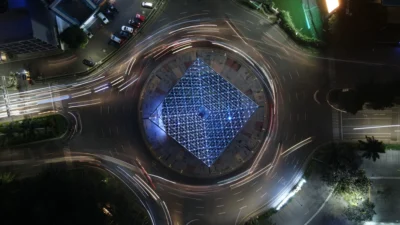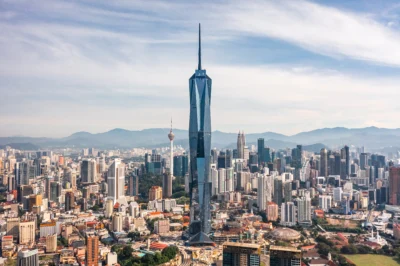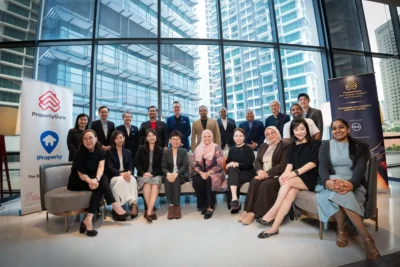Take a tour inside this jet-setting Thai architect’s California home
Openness and connectedness are not typically expected of a concrete box, but Kulapat Yantrasast defies the notion at his stateside home

On a well-to-do street in Venice—not the one with the gondolas, but the Los Angeles beach town where glistening bodybuilders famously pump iron in disturbingly tiny pants on Muscle Beach—the houses all follow a modest sort of protocol. All but one.
Rising defiantly over rows of chaste wooden bungalows is Kulapat Yantrasast’s four-storey, concrete miscreant: part pool house, part design studio, part meditation pavilion—and part multi-storey car park.
Thai-born Yantrasast has lately become the go-to architect for the United States’ finest art institutions—his practice, wHY Architecture, designed Michigan’s Grand Rapids Art Museum, reimagined the Speed Art Museum in Louisville, turned a Masonic Temple in L.A. into the Marciano Art Foundation, and is currently renovating and expanding San Francisco’s Asian Art Museum. This afternoon, however, he’s just happy to be home—at least in the next two hours before the airport. “I travel so much for work, it’s nice to have an excuse to come here,” said Yantrasast of the house he designed for himself.
Wearing his hair in floppy spikes and sporting a pair of chunky, designer black-framed spectacles, Yantrasast is one of those naturally easy, upbeat people, immediately open and warm. Seated at what is technically the dining table but can also be a workbench, gazing at the pool through a wall of glass sliding doors that pull back to create an indoor-outdoor living space, he revealed, “This is my favourite place not just in the house, but the whole world.”
I REALLY SEE ARCHITECTURE AS MORE OF A BRIDGE THAN A WALL. IT ALLOWS YOU TO CONNECT TO CITIES AND NATURE AND THINGS, RATHER THAN CLOSE YOU OFF
Here the intention of his building comes to full focus. “The house is a shelter,” he said, “enclosed on three sides, but also connected to the outdoors.” Yantrasast started with the pool and the garden, and then built an intentionally “skinny” house—just 18 feet wide—“so the architecture would make room for the landscape.” The pool looks straight onto the street, where cars and pedestrians pass by, though he’s planted tall elephant grasses on one side to give his neighbours privacy.
Openness and connectedness might not be what you’d typically expect of a concrete box, but it’s something Yantrasast has achieved time and again with his (also concrete) museums. It’s evident in the concrete canopy that welcomes guests into the Grand Rapids museum, or his studio art building at Claremont’s Pomona Art College, which comprises several concrete box-rooms dotted about an open-air courtyard, covered by a subtly undulating roof. “I really see architecture as more of a bridge than a wall,” related Yantrasast. “It allows you to connect to cities and nature and things, rather than close you off.”
There’s a warmth about Yantrasast’s home, too, that contradicts his brut material. Several dangerously tall piles of books threaten to topple at any moment, and the shelves are chock-full of tchotchkes—anything from wood-carved African animals to plastic action figures. What draws him to such eclectic pieces? “I guess a sense of humanity is what I’m looking for,” he decided. “Objects that feel like someone is having fun with life.”
The home’s delicate balance of structural rigour—Yantrasast likes how concrete doesn’t conceal how the house is built—and human playfulness is a deeply personal aesthetic the architect has honed over more than two decades.
Given his preferred material, it isn’t surprising to learn Yantrasast experienced his “architectural upbringing” under Tadao Ando. The Pritzker Prize-winning Japanese master who designed—among many, many others—the considered concrete museums of Naoshima “art island” and Tokyo’s singular Omotesando Hills shopping mall, practically adopted him. A summer job in Ando’s studio after graduating with an architecture degree at the University of Tokyo turned into eight years of professional partnership—and a room in Ando and his wife’s home. But, in 2003, Yantrasast decided it was time to strike out alone. And so he boarded a plane for Los Angeles.
“I like the clarity and the minimalism of what I learned in Japan,” Yantrasast shared, “but towards the end of my time there, I longed for less rigour; I missed mess and fragrance and flavour. That’s my Thai roots showing! A big reason I came to America was the sense of freedom, the diversity. I liked the possibilities of what can happen when people come from different places and collide with each other.”
This yearning for life’s chaos brought him to Venice, too, formerly more bohemian than today’s gentrified incarnation. “I liked the edge of it,” he mused. “I prefer things on the scruffy side.”
Yantrasast’s house is by no means scruffy. But there is a certain, calculated embrace of the haphazard. The favoured spot where this chat began is on the second floor—the first contains two guest apartments—but, really, the whole building feels like one open, flowing, multi-functional space. Television, sofa, dining/work table, kitchen, books and curiosities all occupy the same open-plan room, and from here you can see into the third floor’s library/studio where there’s also an exercise bike and lots of random bric-a-brac—a Mexican wrestling mask, a rubber duck… “I built my house as a place for me to be happy and do all the things I want,” Yantrasast explained, cheerfully. “I liked the idea of one big space that I could do different things in, rather than a series of small rooms. For me, there’s no line between work and play. There’s no box I want to put things in.”
Ascending a concrete staircase from this floor, one enters into a clear, polycarbonate cube, jutting unapologetically from the roof. It seems a sort of decompression chamber between indoors and outdoors, but Yantrasast conceived it for a more practical use: it lights up at night, glowing like a beacon, and illuminating the al fresco astro-turf so you can hang out here after dusk. Because Venice is low-rise, the view expands over bungalows to distant glass towers and spindly palms. It’s best viewed from “another happy place”—his rooftop trampoline. “Jumping up here, you really feel you’re in the sky,” he laughed.
By now it’s quite clear this house is Kulapat Yantrasast: a considered foundation of serious, technical brilliance, but outwardly fun, open and social. He loves to entertain in it, and that guests can do whatever they like—cook, swim, watch TV—because where some architects use design to control how a space is experienced, Yantrasast believes in being generous with choice.
Choice also influences how he works. Unlike many such accomplished people, who tend to have their own strong (tunnel) vision, Yantrasast relishes collaboration. For that reason, he isn’t committed to concrete, and used various materials in the 10 homes wHY has built for clients—all of whom cold-called, asking for their services.
“It would be a lot easier to apply formulaic solutions, because it’s more time-consuming and less profitable when you’re always starting from scratch,” Yantrasast admitted. But if a person lives an interesting life, he said, their house should be reflect that. “People who like that process and creating something unique gravitate towards us.”
Yantrasast’s house, of course, is an extension of his interesting life, and that’s why you likely won’t see it on the market anytime soon. “I didn’t actually plan on staying here—I thought I’d sell it and move on,” he confided, “but I just can’t bring myself to leave.”
This article originally appeared in Issue No. 148 of PropertyGuru Property Report Magazine
Recommended
6 reasons Bekasi is rising as Greater Jakarta’s next hotspot
One of Greater Jakarta’s rising stars is prospering, thanks to ample recreation and a contingent of desirable housing projects
6 developments driving Asia’s green real estate shift
Developers are being incentivised to push a green agenda into daring new realms
The Philippines’ LIMA Estate drives sustainable industrial growth
LIMA Estate models a citywide vision that uplifts workers while appealing to climate-conscious employers
Malaysia property market rebounds with foreign interest and growth
The nation’s property market is stirring to life, fuelled by foreign buyers and major infrastructure drives










